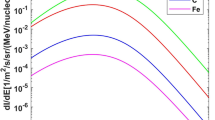Abstract
The measurement of the electron radiation inside the satellite is important for engineering and space environment researches. The particle radiation detectors (PRD) on board CBERS-1 and CBERS-2 made great contribution to understanding of the space environment. Then, what is the radiation relationship between inside and outside the satellite? The Monte Carlo simulation with Geant4 was implemented to study the problem. The boundaries of the energy bins of 0.5 and 2 MeV were precisely corresponding to outside energies of 0.99 and 2.52 MeV, respectively. Besides the changes of the energy bins, the fluxes inside were smaller than those of the corresponding bins outside. The spectrum inside the satellite was harder than that outside. An indicator was that the flux ratio of the high energy bin to the low energy bin increased more than 20% from outside to inside. The geometric factor (GF) relates to the incident energy of electrons. By using the AE-8 model to derive the incident spectrum, the GFs of the low and high energy bins were 1.15 and 0.70 cm2 sr, respectively. GF of the low energy bin was larger than that of the high energy bin. But they were both smaller than the previous results. It was due to the scattering, straggle and shielding effects.
Similar content being viewed by others
References
Xiao Z, Zou J Q, Zou H, et al. Energetic particle detector on board “ZY-1” satellite. Acta Sci Natur Univ Pekin, 2003, 39: 361–369
Xiao Z, Zou H, Wu Z, et al. Energetic particle event observed by a polar orbit satellite at 780 km. Acta Sci Natur Univ Pekin, 2003, 39: 370–374
Zou H, Xiao Z, Zou J Q, et al. A comparison between detections of energetic electron by ZY1/CBMC and SZ2/XD (in Chinese). Chin J Geophy, 2004, 47: 562–570
Zou H, Xiao Z, Hao Y Q, et al. Analysis of the observation of particle detector inside ‘CBERS-1’ satellite under solar quiet conditions. Sci China Ser E-Tech Sci, 2006, 49: 342–357
Zou H, Xiao Z, Hao Y Q, et al. Observation of the disturbed events by the particle detector inside “ZY-1” satellite (in Chinese). Chin J Geophy, 2006, 49: 636–664
Zou H, Chen H F, Zou J Q, et al. Comparison between observation of the particle detector inside ‘ZY-1’ satellite and the model of the radiation belt (in Chinese). Chin J Geophy, 2007, 50: 678–683
Hao Y Q, Xiao Z, Zou H, et al. Energetic particle radiations measured by particle detector on board CBERS-1 satellite. Chin Sci Bull, 2007, 52: 665–670
Zou H. Study on Energetic Particle Radiation Environment Inside Satellite and in Space. Dissertation of Doctoral Degree. Beijing: Peking University, 2003. 45
Chen H F, Shi W H, Zou H, et al. Discussion on the geometric factor in the detection of high energy electrons in geospace. Sci China Ser E-Tech Sci, 2008, 51: 1–9
Li X C, Chen H F, Zou H. Shielding analysis of satellite skin to high energy electron radiation (in Chinese). Abstract Book of the 23rd National Symposium on Space Exploration. XiaMen, 2010. 44
GEANT4 Collaboration, Geant4: A Simulation Toolkit. SLAC Report SLAC-PUB-9350, 2002
Geant4 Home Page. http://geant4.cern.ch/
Ma W G. Computational Physics (in Chinese). Beijing: Science Press, 2005. 6
Jun S L. Monte Carlo Strategies in Scientific Computing. New York: Springer, 2008. 1–19
Yan X J, Chen D. A space energetic electron environment model for spacecraft deep dielectric charging evaluation. Spacecraft Environ Eng, 2008, 25: 120–124
Rodgers D J, Hunter K A, Wrenn G L. The FLUMIC electron environment model. Proc 8th SCTC, Huntsville, 2003
Ryden K A, Morris P A. Observations of internal charging currents in medium earth orbit. IEEE T Plasm Sci, 2008, 36: 2473–2481
SPENVIS Home Page. http://www.spenvis.oma.be/spenvis/
Author information
Authors and Affiliations
Corresponding author
Rights and permissions
About this article
Cite this article
Li, X., Chen, H., Hao, Y. et al. Investigation of electrons inside the satellite by the Geant4 simulation. Sci. China Technol. Sci. 54, 2271–2275 (2011). https://doi.org/10.1007/s11431-011-4521-y
Received:
Accepted:
Published:
Issue Date:
DOI: https://doi.org/10.1007/s11431-011-4521-y




